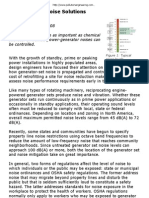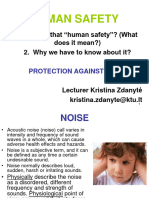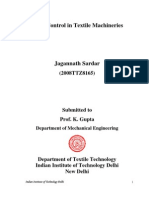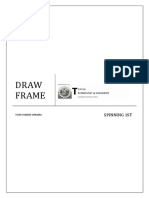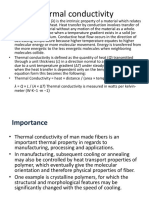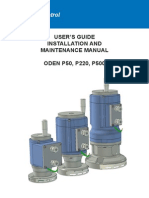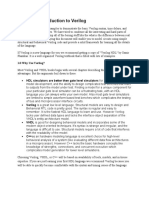0 ratings0% found this document useful (0 votes)
26 viewsES 7, Noise Pollution
ES 7, Noise Pollution
Uploaded by
Sajib IglesiasIndustrial noise pollution is a serious issue, especially in textile industries, where machines produce high levels of noise that can harm workers' health. Measurements in textile industry departments found noise levels exceeding 100 dB in some areas like ring frames and loom sheds. Prolonged exposure to noises over 85-90 dB can cause permanent hearing loss and other issues like cardiovascular problems and sleep disorders. To reduce noise, industries should implement solutions like using resilient materials in machines, adding noise enclosures, proper maintenance, and vibration isolation. Bangladesh has established legal noise level limits that vary based on zone and time of day.
Copyright:
© All Rights Reserved
Available Formats
Download as PDF, TXT or read online from Scribd
ES 7, Noise Pollution
ES 7, Noise Pollution
Uploaded by
Sajib Iglesias0 ratings0% found this document useful (0 votes)
26 views11 pagesIndustrial noise pollution is a serious issue, especially in textile industries, where machines produce high levels of noise that can harm workers' health. Measurements in textile industry departments found noise levels exceeding 100 dB in some areas like ring frames and loom sheds. Prolonged exposure to noises over 85-90 dB can cause permanent hearing loss and other issues like cardiovascular problems and sleep disorders. To reduce noise, industries should implement solutions like using resilient materials in machines, adding noise enclosures, proper maintenance, and vibration isolation. Bangladesh has established legal noise level limits that vary based on zone and time of day.
Original Title
ES 7, noise pollution
Copyright
© © All Rights Reserved
Available Formats
PDF, TXT or read online from Scribd
Share this document
Did you find this document useful?
Is this content inappropriate?
Industrial noise pollution is a serious issue, especially in textile industries, where machines produce high levels of noise that can harm workers' health. Measurements in textile industry departments found noise levels exceeding 100 dB in some areas like ring frames and loom sheds. Prolonged exposure to noises over 85-90 dB can cause permanent hearing loss and other issues like cardiovascular problems and sleep disorders. To reduce noise, industries should implement solutions like using resilient materials in machines, adding noise enclosures, proper maintenance, and vibration isolation. Bangladesh has established legal noise level limits that vary based on zone and time of day.
Copyright:
© All Rights Reserved
Available Formats
Download as PDF, TXT or read online from Scribd
Download as pdf or txt
0 ratings0% found this document useful (0 votes)
26 views11 pagesES 7, Noise Pollution
ES 7, Noise Pollution
Uploaded by
Sajib IglesiasIndustrial noise pollution is a serious issue, especially in textile industries, where machines produce high levels of noise that can harm workers' health. Measurements in textile industry departments found noise levels exceeding 100 dB in some areas like ring frames and loom sheds. Prolonged exposure to noises over 85-90 dB can cause permanent hearing loss and other issues like cardiovascular problems and sleep disorders. To reduce noise, industries should implement solutions like using resilient materials in machines, adding noise enclosures, proper maintenance, and vibration isolation. Bangladesh has established legal noise level limits that vary based on zone and time of day.
Copyright:
© All Rights Reserved
Available Formats
Download as PDF, TXT or read online from Scribd
Download as pdf or txt
You are on page 1of 11
Industrial Noise pollution
Md. Shakirul islam
Lecturer, WPE,
BUTEX
ASPECT
• With the progress of industrial growth, noise has become a part of our
environment.
• Development of modern automated machines in textile industries has
considerably decreased the physical burden of work on workers but one of
the most undesirable and unavoidable product of these machines are noise
pollution.
• High level noise, not only hinders communication between the workers also
depending upon the level, quality and exposure duration of noise have
physical, physiological and psychological effects on the workers.
• In developing countries also, there has been a great concern about the
magnitude of industrial noise exposure, particularly in textile industry
Parameters of sound measurement
• Two important parameters of sound/noise are sound pressure and
sound intensity. The common scientific acoustic unit is decibel (dB). It
is a ratio expressed as a logarithmic scale relative to a reference sound
pressure level.
• 1 decibel (dB) =10 log10 (Intensity Measured /Reference Intensity)
• In other way, Sound is usually measured in terms of the sound
pressure level, SPL, which is defined as
SPL= 20 decibels(dB)
Sources
There are two types of sources of noise pollution in general
• Many primary sources of noise exist in industrial situations. Common
primary sources are interacting parts such as gear teeth and bearings,
motion of pistons between end-stops in hydraulic and pneumatic
actuators, air and gas jets, combustion processes and vibrating
components.
• However, noise from primary sources is frequently reflected from
various boundaries in the environment. Each such boundary becomes a
secondary noise source and often results in a standing wave, such that
sound is nullified in some positions but reinforced in others.
Noise level observed in the different departments of textile
industry
Area Noise exposure level in dB
Blow room 84.8
Carding 89.9
Draw Frame 85.2
Combing 84.4
Simplex 87.2
Ring Frame 100
Loom Shed 102.1
Cheese Winding 91.2
SOUND METER
• Sound is usually measured with a sound meter. The sound meter is a
useful tool for investigating complaints about noise pollution. In its
normal mode of operation, it gives an output that is compensated for
the nonlinear sensitivity of the human ear and therefore gives a fair
measurement of the long-term degree of noise pollution existing.
Mechanism:
1. Sound meter processes the signal collected by a microphone. The
microphone is a diaphragm type pressure-measuring device that
converts sound pressure into a displacement.
2. The displacement is applied to a displacement transducer (normally
capacitive, inductive or piezoelectric type) which produces a low-
magnitude voltage output
SOUND METER
3. This is amplified, filtered and finally gives an output voltage signal
that can be recorded.
4. The filtering process has a frequency response approximating that of
the human ear, so that the sound meter ‘hears’ sounds in the same way
as a human ear. So that the sound level measurement output accurately
reflects the sound level heard by human.
Sound Output display
Microphone Amplifier Filter
r.m.s. voltmeter
HAZARDS OF NOISE POLLUTION
Workers consistently exposed to the noise levels above 85 or even 90 dB
may reveal permanent hearing loss. Prevalence of noise induced hearing
loss was highest in the workers working in weaving area, followed by the
spinning workers and the workers working in TFO, doubling area. In
addition to hearing loss, exposure of workers to noise levels of 90-119 dB
was also found to result in-
1. Cardiovascular and psycho physiologic problems.
2. Sleep disorders and headache,
3. Mental fatigue, Annoyance, speech interference and reduced
alertness,
4. Increased blood pressure, deep body temperature and pulse rate,
5. Speed of performance was impaired significantly by noise.
CONTROL OF NOISE POLLUTION IN TEXTILE INDUSTRY
• Noise in spinning section can be reduced by providing elastomeric spindle.
• Replacement of parts with resilient materials like nylon instead of metal can
provide reduction in impulse noise of looms.
• Attempts shall be made to produce complete enclosures around the loom. A
complete enclosure can provide, greater degree of reduction ranging from 30 dB
to over 60 dB depending upon the design.
• Proper maintenance by ensuring the following:
I. Reduction of imbalance through proper alignment and balancing of rotating
equipment
II. Replacement of worn parts, such as bearing, gears and other moving parts.
.
CONTROL OF NOISE POLLUTION IN TEXTILE INDUSTRY
III. Regular lubrication to reduce friction.
IV. Tightening of loose parts.
V. Correct assembly of machine parts or replacements.
• Vibration isolators prevent noise from being transmitted through the
base of the equipment
• Damping or foamed coatings reduce sound amplitude and duration
In Bangladesh, the sound intensity standard is set by the
Department of Environment (VIDE RULE 12) as below
ZONE CLASS DAY (6am -9pm) NIGHT (9pm-6am)
SILENT ZONE 45 dB 35
RESIDENTIAL ZONE 50 dB 40
MIXED ZONE 60 dB 50
COMMERCIAL ZONE 70 dB 60
INDUSTRIAL ZONE 70 dB 70
You might also like
- Iso 5019 1 1984Document4 pagesIso 5019 1 1984emregnesNo ratings yet
- Volvo V40 PricelistDocument24 pagesVolvo V40 Pricelistsaran2rasu100% (1)
- Astm A307-21Document6 pagesAstm A307-21jairo F. Arroyo MNo ratings yet
- Heat SettingDocument17 pagesHeat SettingSajib Iglesias100% (1)
- Free Acceleration of Induction MachineDocument68 pagesFree Acceleration of Induction MachineMani MaranNo ratings yet
- A Presentation On Noise PollutionDocument22 pagesA Presentation On Noise PollutionDinesh Pant100% (1)
- Noise PollutionDocument16 pagesNoise PollutionNaimur Rahim ChowdhuryNo ratings yet
- Noise Pollution in Oil and Gas IndustryDocument26 pagesNoise Pollution in Oil and Gas IndustryPalak JoshiNo ratings yet
- Noise Pollution in The Textile IndustryDocument9 pagesNoise Pollution in The Textile IndustryAmmar Maqsood0% (1)
- Physical Aspect of Work Environment IHS GTUDocument47 pagesPhysical Aspect of Work Environment IHS GTUMan PatelNo ratings yet
- Lec#06 EnvE - Noise PollutionDocument13 pagesLec#06 EnvE - Noise PollutionqamarVEXNo ratings yet
- Safety - Lecture 5Document33 pagesSafety - Lecture 5Tamer MohamedNo ratings yet
- Module - V: Acoustics and Enviornmental Noise Control Binil Babu, Dept. of Mechanical Engineering, SNMIMT, MaliankaraDocument19 pagesModule - V: Acoustics and Enviornmental Noise Control Binil Babu, Dept. of Mechanical Engineering, SNMIMT, Maliankarabinil babuNo ratings yet
- Noise PollutionDocument77 pagesNoise PollutionLianne PeñalosaNo ratings yet
- IE558 - Chapter 22Document40 pagesIE558 - Chapter 22h8wvk5y22zNo ratings yet
- STC 5 - Group 13 - 4 A - Summary - Physical and Psychological Hazards and ControlDocument13 pagesSTC 5 - Group 13 - 4 A - Summary - Physical and Psychological Hazards and ControlVincent Ronin SerratoNo ratings yet
- Topic 10 Noise & Noise ControlDocument30 pagesTopic 10 Noise & Noise ControlaileehzreenNo ratings yet
- Lecture 2 - Noise Pollution and ControlDocument20 pagesLecture 2 - Noise Pollution and ControlzeeshanabidbhattiNo ratings yet
- 2.QAGuide8 GC 2 PDFDocument6 pages2.QAGuide8 GC 2 PDFekkyagungNo ratings yet
- TOPIC 10:: Noise & Noise ControlDocument30 pagesTOPIC 10:: Noise & Noise ControlasNo ratings yet
- STUDENTS Lecture 3 (Chapter 2)Document29 pagesSTUDENTS Lecture 3 (Chapter 2)Sirine AjourNo ratings yet
- Noise Level StandardDocument14 pagesNoise Level StandardSyazwani NasirNo ratings yet
- NoiseDocument8 pagesNoiseswasthmiaerNo ratings yet
- Module V EVS101 Noise PollutionDocument30 pagesModule V EVS101 Noise PollutionTamo JitNo ratings yet
- Noise PollutionDocument40 pagesNoise PollutionAmit KhadkaNo ratings yet
- CE4810 Noise W12Document12 pagesCE4810 Noise W12Khimavath BharathNo ratings yet
- Noise PollutionDocument27 pagesNoise PollutionNazish AnwarNo ratings yet
- 24 - Controlling Sound Hazards in The WorkplaceDocument6 pages24 - Controlling Sound Hazards in The WorkplacefishingduyNo ratings yet
- Noise Measurements, Standards and Control TechniquesDocument42 pagesNoise Measurements, Standards and Control TechniquesPrabhu PrasadNo ratings yet
- Noise Pollution Paper 2.1Document11 pagesNoise Pollution Paper 2.1anilNo ratings yet
- Genset Noise SolutionDocument7 pagesGenset Noise Solutionroni15100% (1)
- topic 4 Chapter 6 - Noise PollutionDocument36 pagestopic 4 Chapter 6 - Noise PollutionnooralifizzuddinraemiNo ratings yet
- Protect Against NoiseDocument42 pagesProtect Against NoiseAle Al AliwiNo ratings yet
- Noise Pollution and Its Control in Textile IndustryDocument6 pagesNoise Pollution and Its Control in Textile IndustryAmir ShahzadNo ratings yet
- SLM Apad LatestDocument16 pagesSLM Apad Latestnurfadhilah_rosliNo ratings yet
- Noise Pollution NcnDocument8 pagesNoise Pollution Ncnradhekrishna85411No ratings yet
- Chapter 2 - Noise PollutionDocument39 pagesChapter 2 - Noise PollutionLionel MessiNo ratings yet
- Lec11 Causes, Effects and Control of Noise and Thermal PollutionDocument10 pagesLec11 Causes, Effects and Control of Noise and Thermal Pollutionkuldeep945350No ratings yet
- Pages From Noise and ThermalDocument7 pagesPages From Noise and Thermalig.hader55No ratings yet
- HSE Handout Week 8Document34 pagesHSE Handout Week 8ALIYAN ALINo ratings yet
- I. Noise What Is Noise?Document17 pagesI. Noise What Is Noise?Nguyễn Lê Minh NhậtNo ratings yet
- Sound MeasurementsDocument26 pagesSound MeasurementsAnuraag Singh100% (1)
- Noise PollutionDocument44 pagesNoise Pollutioniphonephotos1803No ratings yet
- 4 - Sound and NoiseDocument56 pages4 - Sound and NoisegfromsomewhereNo ratings yet
- Noise Exposure at WorkplaceDocument56 pagesNoise Exposure at WorkplaceJohn OoNo ratings yet
- Noise: Unwanted SoundDocument84 pagesNoise: Unwanted SoundMatthew PerryNo ratings yet
- HVAC NoiseDocument41 pagesHVAC Noisesp su100% (3)
- Elimination of Other Hazard, Noise, Radiation, EtcDocument34 pagesElimination of Other Hazard, Noise, Radiation, EtcJake MillerNo ratings yet
- Noise PolutionDocument48 pagesNoise Polutionhimanshu_agraNo ratings yet
- Noise Control in Textile MachineriesDocument40 pagesNoise Control in Textile MachineriesJagannath SardarNo ratings yet
- 5.2 Noise at WorkDocument6 pages5.2 Noise at WorktedjinielalmiNo ratings yet
- PPT3-W3-S5-PJJ TDDocument48 pagesPPT3-W3-S5-PJJ TDFebrian F. F.No ratings yet
- 3 Osha NoiseDocument7 pages3 Osha NoiseAlaa AllamNo ratings yet
- INDUSTRIAL ENGG - LAB (Exp-4) 6053RDocument6 pagesINDUSTRIAL ENGG - LAB (Exp-4) 6053Rpatel1029poojaNo ratings yet
- Noisepollutions FinalDocument38 pagesNoisepollutions FinalJaiGokhoolaNo ratings yet
- Noise Control Design GuideDocument44 pagesNoise Control Design Guidejorgeblotta3489No ratings yet
- Noise Pollution and Its ControlDocument40 pagesNoise Pollution and Its ControlDhananjay ShimpiNo ratings yet
- Light NoteDocument39 pagesLight NoteNur Amalina AzizNo ratings yet
- NoiseDocument10 pagesNoiseShane Danikka LlorinNo ratings yet
- Noise PollutionDocument37 pagesNoise Pollutionsefok90385No ratings yet
- Controlling Noise From Compressed Air SystemsDocument5 pagesControlling Noise From Compressed Air SystemsHamed LavaeeNo ratings yet
- En32eh Consnoise M.WDocument14 pagesEn32eh Consnoise M.WYekhetheloNo ratings yet
- Defining Sound FieldsDocument10 pagesDefining Sound FieldshahahahahaNo ratings yet
- Hearing ConservationDocument7 pagesHearing ConservationJenil TNo ratings yet
- Draw Frame1Document26 pagesDraw Frame1Sajib IglesiasNo ratings yet
- Effluent Treatment PlantDocument20 pagesEffluent Treatment PlantSajib IglesiasNo ratings yet
- Air JetDocument12 pagesAir JetSajib Iglesias100% (1)
- Effluent Treatment PlantDocument20 pagesEffluent Treatment PlantSajib IglesiasNo ratings yet
- Revision ExercisesDocument7 pagesRevision Exercisesনীল জোছনাNo ratings yet
- Necessary Calculation For Yarn Manufacturing Course: Answer: 1022 KGS/ 24 Hour 1.022 MT / 24 HourDocument1 pageNecessary Calculation For Yarn Manufacturing Course: Answer: 1022 KGS/ 24 Hour 1.022 MT / 24 HourSajib IglesiasNo ratings yet
- Reference Books: Operations", The Textile Institute, Manchester 1995Document25 pagesReference Books: Operations", The Textile Institute, Manchester 1995Sajib IglesiasNo ratings yet
- Bangladesh University of Textiles: SubjectDocument2 pagesBangladesh University of Textiles: SubjectSajib IglesiasNo ratings yet
- Lecture 5 Dobby Shedding (JBA)Document17 pagesLecture 5 Dobby Shedding (JBA)Sajib Iglesias100% (1)
- Bangladesh University of Textiles: IndexDocument2 pagesBangladesh University of Textiles: IndexSajib IglesiasNo ratings yet
- Thermal ConductivityDocument4 pagesThermal ConductivitySajib IglesiasNo ratings yet
- Lab4 PDFDocument14 pagesLab4 PDFSajib IglesiasNo ratings yet
- Mechanism and Mechanical Vibration (Lab Work) Teaching PlanDocument8 pagesMechanism and Mechanical Vibration (Lab Work) Teaching PlanBelia NomeNo ratings yet
- Sales Management Information System - MISDocument32 pagesSales Management Information System - MISJyotindra Zaveri E-Library86% (7)
- Test Java Fundamentals Final ExamDocument16 pagesTest Java Fundamentals Final ExamtwintyNo ratings yet
- L1 - 320introduction - Lec1Document26 pagesL1 - 320introduction - Lec1Mais SaedNo ratings yet
- Testing SW Concept 1200317215102236 3Document251 pagesTesting SW Concept 1200317215102236 3leogopal0% (1)
- Manual P50 P220 P500 20080915Document30 pagesManual P50 P220 P500 20080915Mario VillanuevaNo ratings yet
- BMS Key File ManualDocument54 pagesBMS Key File ManualDave91No ratings yet
- Assignment 3 Ujmd2003 Illustration Uides Brief 202406Document3 pagesAssignment 3 Ujmd2003 Illustration Uides Brief 202406rubentseNo ratings yet
- As Built DammamDocument12 pagesAs Built DammamShah MuzzamilNo ratings yet
- Membership FormDocument6 pagesMembership FormJudeJararthNo ratings yet
- HCI-chapter 4Document66 pagesHCI-chapter 4Habtamu AbateNo ratings yet
- Manual Simulator TechSimDocument246 pagesManual Simulator TechSimAlefterix Anca100% (1)
- SDR BTS Commissioning Guide - UMTS PDFDocument31 pagesSDR BTS Commissioning Guide - UMTS PDFMuhammad Kashif100% (2)
- Python Input and Output StatementsDocument5 pagesPython Input and Output StatementsNarendra Chauhan100% (3)
- Scientific Management Theory and The Ford Motor CompanyDocument4 pagesScientific Management Theory and The Ford Motor CompanyYan Kim LeongNo ratings yet
- ML11346A631Document26 pagesML11346A631iraq222vvpNo ratings yet
- UT640S (ASIA) - Datasheet - TV Signage - Commercial TV - ID - LOW - 190705Document9 pagesUT640S (ASIA) - Datasheet - TV Signage - Commercial TV - ID - LOW - 190705OctavianusNo ratings yet
- ZXA10 F460B User Manual - 298496Document156 pagesZXA10 F460B User Manual - 298496Alexander PischulinNo ratings yet
- Chapter1: Introduction To VerilogDocument15 pagesChapter1: Introduction To Verilogarunguptha_gsNo ratings yet
- ContentWeightages Junior Forensic ScientistDocument3 pagesContentWeightages Junior Forensic ScientistabdulNo ratings yet
- Proposal Chinmay BallaDocument2 pagesProposal Chinmay Ballanaveenbabu19No ratings yet
- Bernhard Schulte Shipmanagement - Case StoryDocument1 pageBernhard Schulte Shipmanagement - Case Storysrinup28No ratings yet
- Gand MarwaDocument2 pagesGand MarwarohanadityaborahNo ratings yet
- Eclipse Driver E4-5-6-7 - ManualDocument99 pagesEclipse Driver E4-5-6-7 - ManualJoseAntonioMolinaVeraNo ratings yet
- Ethics in Technology Exam QuestionsDocument2 pagesEthics in Technology Exam QuestionsdrnikolashesselNo ratings yet
- Ecemea Optiplex 7040 Technical Spec Sheet PDFDocument3 pagesEcemea Optiplex 7040 Technical Spec Sheet PDFNisar AhmedNo ratings yet






























